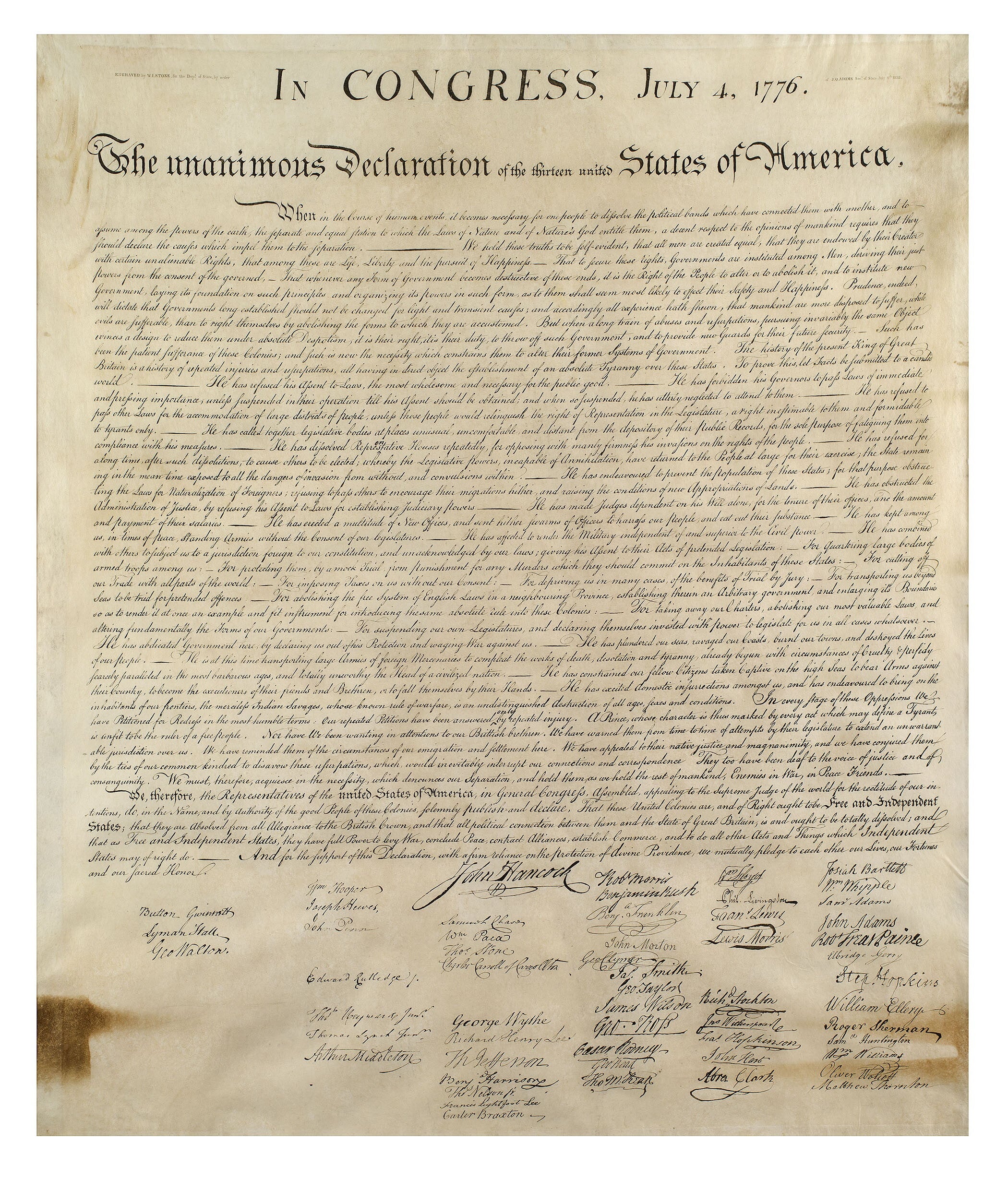Spotlights on Primary Sources
The documents featured here demonstrate how the ideals of the Declaration of Independence have carried on throughout American history. Each of the Spotlights from our Collection provides explanatory text, Questions for Discussion, a transcript, and an image of the featured document. Questions for classroom discussion are available to K–12 teachers.
Declaration of Independence, 1776
In 1776, Peter Timothy of Charleston printed this copy of the Declaration of Independence and brought the news of independence to South Carolina. In doing so, he risked his life.
Texas Declaration of Independence, 1836
The Texas Declaration of Independence was signed at Washington-on-the-Brazos, now commonly referred to as the “birthplace of Texas.” Similar to the United States Declaration of Independence, this document focuses on the rights of citizens to “life” and “liberty” but with an emphasis on the “property of the citizen.”
William Jennings Bryan and the Ideals of the Declaration of Independence, 1895
William Jennings Bryan compared contemporary events in business and banking to Andrew Jackson’s destruction of the Bank of the United States and then concentrated on Thomas Jefferson’s statement in the Declaration of Independence that “all men are created equal.”
An Appeal for Suffrage Support, 1871
The National Woman Suffrage and Educational Committee, including President Isabella Beecher Hooker and Susan B. Anthony, reminds women of their grievances, such as taxation without representation, a trial by those who are not their peers, and living under laws they had no voice in making. They refer to the Declaration of Independence in saying, “your rights to life, liberty and the pursuit of happiness are daily infringed, simply because you have heretofore been denied the use of the ballot, the one weapon of protection and defence under a republican form of government.”
Voting Restrictions for African Americans, 1944
This 1944 pamphlet explains poll times, compensation, voting requirements, absentee voting, voter turnout from previous elections, and the expected voter turnout of African Americans. The reports on North Carolina and Mississippi demonstrate different aspects of voter suppression. In North Carolina, although the state constitution says, “All men are created equal,” a prominent Black community member in Black Mountain was told that “if he registered, he would lose his job and would have to leave the town.”
Fewer than 275 words in length, Abraham Lincoln’s three-minute-long Gettysburg Address defined the meaning of the Civil War. Drawing upon the biblical concepts of suffering, consecration, and resurrection, he described the war as a momentous chapter in the global struggle for self-government, liberty, and equality. Lincoln told the crowd that the nation would “have a new birth of freedom, and that government of the people, by the people, for the people shall not perish from the earth.” He stated that the Union had to remain dedicated to “the great task remaining before us” with “increased devotion to that cause for which” the dead had given "the last full measure of devotion.”
Inside the Vault: Highlights from the Gilder Lehrman Collection
Inside the Vault: Highlights from the Gilder Lehrman Collection is an online program that highlights unique primary sources from the Gilder Lehrman Collection. From iconic historical treasures, such as the Declaration of Independence, the US Constitution, and the Emancipation Proclamation, to personal letters that reveal the contributions of ordinary American citizens, each session investigates primary sources and discusses their background, impact, and potential use in the classroom. The documents featured here demonstrate how the ideals of the Declaration of Independence have carried on throughout American history.
The Declaration of Independence
The July 1, 2021, session of Inside the Vault explores the history behind the William J. Stone printing of the Declaration of Independence and how news of the Declaration was received. Documents include William J. Stone’s printing of the Declaration of Independence, William Whipple’s description of the reception of the Declaration in New York, a German print with a fictitious view of pulling down King George’s statue, and a British pamphlet entitled An Answer to the Declaration of the American Congress (printed in London).
The June 26, 2020, edition of Inside the Vault explores a rare South Carolina printing of the Declaration of Independence and a soldier’s experience at the Battle of Gettysburg. The Collection’s curators were joined by Mandel Holland, an educator at Woodlands Middle High School in Hartsdale, New York, and Peter Vermilyea, an educator at Housatonic Valley Regional High School in Falls Village, Connecticut, and Western Connecticut State University.
In the May 1, 2020, Inside the Vault, Kevin Cline, 2016 National History Teacher of the Year, joined the Institute’s curators to explore and analyze Paul Revere’s engraving depicting the Boston Massacre and Philip Dawe’s print “Bostonians Paying the Excise-man.”
Black Patriots of the American Revolution
Originally broadcast on October 29, 2020, this session of Inside the Vault explores unique documents from the Gilder Lehrman Collection that record the service of Black soldiers in the Continental Army and reveal their postwar experiences. Joining us for this discussion were panelists Mandel Holland, a history teacher from Woodlands Middle High School in Hartsdale, NY, and Meecah from the cast of Hamilton. We used documents to investigate the lives and military service of Cuffee Saunders, Quaco, Romeo Smith, and Peter Kiteredge, and discussed the challenges of researching the lives of these men.
